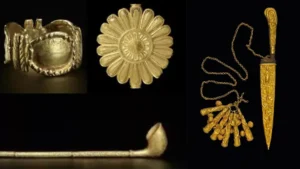The Ethical Dilemma of Repatriating Stolen Artifacts
In a historic move, the British Museum and the Victoria & Albert Museum (V&A) have agreed to a three-year loan of Ghana’s “Crown Jewels,” the Asante Treasures, marking a significant step in the restitution of looted African artifacts. These treasures, comprising 32 gold and silver pieces of court regalia, were pillaged from the collection of the Asante king during the 19th and 20th century Anglo-Ashanti wars.

The decision to loan these artifacts back to Ghana raises important ethical questions about the ownership and rightful place of cultural heritage. The Asante people, renowned for their rich economy and military prowess, consider these items not just as objects but as pieces of their soul and identity. Returning them signifies more than a mere transaction; it signifies a step towards healing the wounds of colonialism and acknowledging the cultural rights of sovereign nations.
However, the loan is not without controversy. Many national museums in the UK, including the British Museum and the V&A, are legally barred from permanently returning items in their collections. Instead, long-term loan agreements have become a popular compromise. While these loans can be seen as a step forward in acknowledging historical injustices, they also highlight the persistent power dynamics between former colonizers and colonized nations.
The loan agreement was made with Otumfo Osei Tutu II, the current Asante king, rather than the Ghanaian government, underscoring the influence of traditional rulers in the country’s cultural affairs. This raises questions about the role of traditional authorities in negotiating the return of cultural heritage and the involvement of national governments in such matters.
Moreover, this loan deal has broader implications for the repatriation of looted African art and culture. Similar cases, such as the ongoing dispute over the Parthenon Marbles, highlight the complexities of cultural repatriation and the resistance of former colonial powers to relinquish control over these artifacts.
In conclusion, while the loan of the Asante “Crown Jewels” is a step in the right direction, it also underscores the need for a more comprehensive approach to the repatriation of looted African artifacts. This approach should prioritize the voices and rights of the communities from which these artifacts were taken and address the broader implications of colonial legacies on cultural heritage.

Leave a Reply
You must be logged in to post a comment.